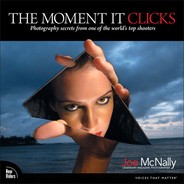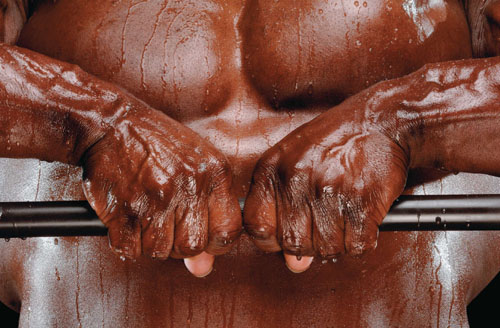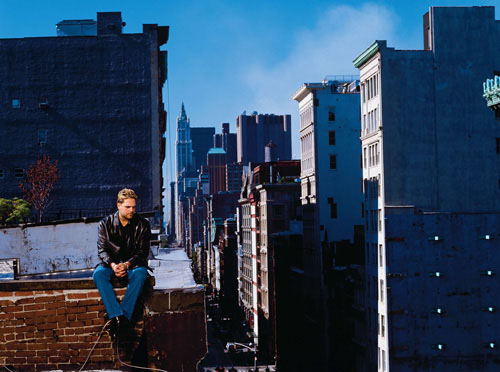“Is the only good light available light? Yes.
When I was in school, I wanted to be W. Eugene Smith. He was a legendary staffer at Life, a consummate photojournalist, and an architect of the photo essay. He was also kinda crazy.
That was obvious when he came to lecture at Syracuse University and put a glass of milk and a glass of vodka on the lectern. Both were gone at the end of the talk. He was taking questions and I was in the front row, hanging on every word.
“Mr. Smith, is the only good light available light?” came the question.
He leaned into the microphone. “Yes,” he baritoned, and paused.
A shudder ran through all of us. That was it! No more flash! God’s light or nothing!
But then he leaned back into the mic, “By that, I mean, any &*%%@$ light that’s available.”
Point taken.
By that, I mean, any &*%%@$ light that’s available.”

For the A Day in the Life of Ireland book, I wanted to photograph Irish coal miners. I went to Kilkenny, a small village. Met my contact at the local pub (where else?) and asked him about the nearby mine. I was excited to check it out.
He nodded and rubbed his chin. “Yah, yah, we got the mine for sure. Can take ye out there for sure. Thing is, it’s been closed for nigh on 20 year.” Welcome to “Day in the Life” research!
I did go, and crawled down into a deep, black hole, just to be sure. I turned back, probably just before the sign, “No pictures here.”
Okay. What to shoot? I love weddings, so I went and started to check out churches and schedules. The luck of the Irish prevailed and, quite literally, the farmer’s daughter was getting married on the day of the book shoot. Met the family. They said yes.
What a wonderful day! Weddings are fun, ‘cause people let their hair down and, of course, in Ireland, they really let their hair down. Had a ball and made some fun pics.
Almost at the end of the night, the father of the bride came up to me. He was a farmer—barrel-chested, silver hair, forearms like Popeye. He grabbed me by the shoulders. “I don’t give a $#!& about the photos,” he shouted over the music. “Are ye having a good time?”
When the good times are rolling, you gotta roll with them, and show the frenzy, the fun, and the motion. How do you show things in motion when you are holding a still camera in your hands?

“How do you show motion when you have a still camera in your hands? Rear curtain is the way to go.”
“Remember, babies are soft and cuddly. Light accordingly.”
Baby shoots are tough. Ya gotta have lots of the little tykes hanging around, ’cause most of ‘em aren’t going to cooperate. “Next baby!” you end up shouting and the next eager mother steps up with Junior in her arms.
To do a good baby shoot, it actually helps if you’ve had a couple of ‘em yourself. I had young assistants on this shoot, pre-fatherhood, and there were a couple of moments.
Like when one of the assistants brought the tot here onto the set, plopped him on the seamless background, and walked away. Poor little guy teetered upright for a moment and then the baby went BOOM!
“My baby!” screamed the mom, anxiously fluttering around him, while he didn’t have a clue about the fuss. We got him comfortable and he performed like a champ.
Off to the side, I pointed out to the assistant that the baby was not a beer keg. He was a baby, and babies like to get sort of settled in and comfy before you leave them off on their own.
It’s tough, though. To get the reaction you want, you have to do ridiculous things, and sometimes even be kind of a schnook. Like dangling a Cheerio in front of the kid and then, just as he reaches for it, snatching it away. I mean, you get a picture, but man, you feel like dirt.
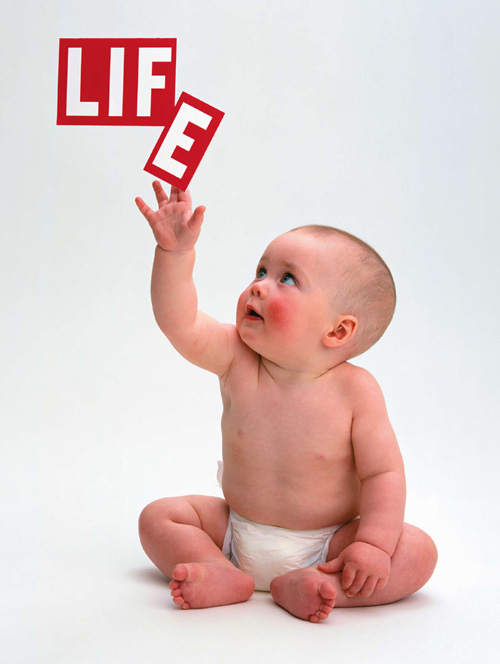
I spent seven fun-filled days with Donald Trump back in the roaring ‘80s. As I recall, he had a driver named Big Tony. I made friends with Tony. We made small talk about the Mets and the Yankees and I gave him a bunch of color neg film.
He would, in turn, tell me Trump’s itinerary for the day and when he needed a car. So whenever Trump came down to get into the limo, I’d already be in it.
He didn’t really want me in there, but he was too cool to make a scene. He would just give me that, “What the *#@! are you doin’ in my limo?” look.
And off we’d go.
“Make friends with the people surrounding the big shot.”
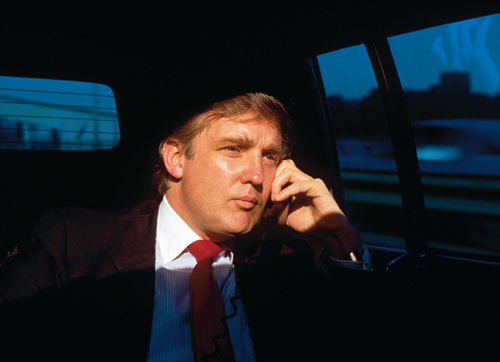
Donald Trump
Ronnie Coleman
“When shooting a story about someone, their hands should always be on your list to shoot.”
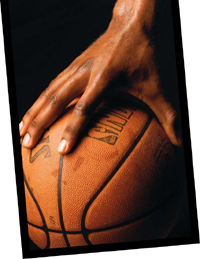
Photographing hands has been one of my favorite activities, even to the point of suggesting to Sports Illustrated that we show a life in sports by photographing just the hands of the athletes.
They approved it, and then killed it during a budget cut.
It was fun while it lasted. Around the photo department, the story was affectionately dubbed “the hand job.”
But ever since taking a class from Life DOP John Loengard all those years ago, hands fascinate me. When shooting a story about someone, their hands should always be on your list to shoot.

Ronnie Coleman
“Time was, you had to drag in the Polaroid and wander the room with an incident light meter. Now, we can just go click.”
Just go click. That’s a simple way of talking about an incredibly crucial, immediate thought process that has to take place when you show up. In more formal terms, we’re talking location assessment.
Time was, you had to drag in the Polaroid and wander the room with an incident light meter, sorting out hot spots and shadows. Then you’d shoot a series of 90-second guestimates, wait for them to develop, and make some judgments based on material that was often off-color, lacked the same exposure range as the real film in the camera, and had marginal detail.
Now, we can just go click. That LCD! What an amazing thing and they’re just getting better. Gives us a whole ton of information right away. You can see where dead zones are, how much or how little light to use, exact composition, shadow detail, histogram info, metadata, what you had for breakfast (kidding!), and the whole nine yards. (I always tell my classes, eventually they’re gonna make a camera system so intuitive that you’ll do the first scouting picture and the LCD will return a set of messages instead of a picture. “Go elsewhere! You’re screwed! You sure you wanna use that lens?”)
You are now Polaroiding with exactitude inside the same camera you’re gonna use to make the shot. No guesswork. No dragging out attachments or a whole other camera system with an accordion bellows that looked like you were in search of a good polka instead of a picture.
It doesn’t matter if the first look is even a reasonable f-stop/shutter speed combo. It’s information. It’s immediate. It gives you a starting point. Think of it as the photo weather report. Is it gonna be a good day or a bad day?
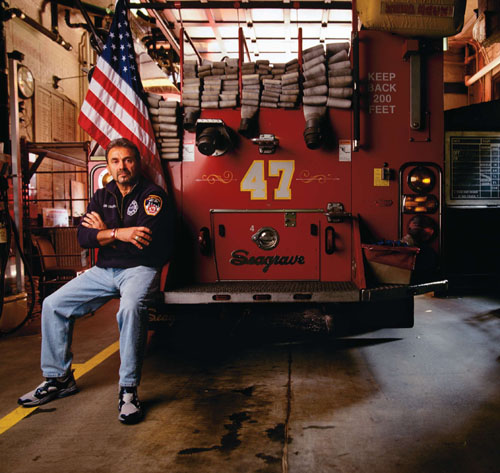
“To show scale, light the whole environment, and then highlight the subject.”
I was working in Star City, the Russian space training center. It’s a place that, during the Cold War, was not on any maps. Now, in the spirit of openness and trust that exists between Russia and America—not to mention the sharing of technology, expertise, and the exchange of cold, hard cash—American astronauts and Russian cosmonauts live and train together here.
One of the challenges of the story was lighting the world’s largest centrifuge by myself. (“World’s largest centrifuge!” said my contact. “Thousand dollars, make it spin.”) I didn’t have that kind of dough, so I had to shoot it just sitting there. The key to the picture was to establish a sense of scale: tiny human being and monster machine.
Lighting is a good way to show scale, so I asked Wendy Lawrence, NASA’s most diminutive astronaut, to get into the pod. I lit her with two large battery-operated strobes, drawing attention to her size relative to the machine. I threw a couple other large strobes behind the machine, aimed at the far wall to create some separation. I shot this with a wide-angle lens to establish how enormous this device is. The lights on her are gelled warm, which resonates well against the cool overall lighting of the building.
To get all this done, I first had to write a letter to the commandant, a formidable Russian by the name of General Pyotr Klimuk. The Russian assistant in the NASA Star City office was helping me translate, typing the letter in Cyrillic.
“What is your title?” she asked in her heavy accent. I told her I was a photographer. She shook her head vigorously. “Photographer does not write letter to General Klimuk. You must call yourself somesing else.”
“Okay,” I said. “How about ‘project coordinator’?”
“Zees is better,” she said, finishing her typing.
Sometimes (we can’t help it) as photographers, we get to liking ourselves too damn much, and really think a great deal of our abilities and our place in the universe. Then we run into a Russian commandant and find out it’s actually better to be a project coordinator.

“Light speaks, just like language. You can make someone look like an angel, or the devil.”
Do the math. You’re not going to light the grandmother of the year for an article in the hometown Daily Astonisher with a ring light.[1] It doesn’t matter if you just got the ring light from B&H and you’re dying to use it.
[1] Ring Light: A circular light source that wraps around the barrel of the lens. Produces a hard, shadowless light. Very popular with fashion photogs.
Grandma’s got to be lit softly, gently. Save the ring light for the local tattoo queen, or Mr. Lifto from the Jim Rose Circus. Light speaks, just like language. You can make someone look like an angel, or the devil. Take a look at Arnold Newman’s famous portrait of Krupp, the German industrialist. Light speaks louder than words.
[2] Honeycomb Spot Grid: A circular metal grid (that looks like a honeycomb) that goes over your strobe head and limits the spread of the light.

Mr. Lifto
When I was assigned to shoot Steve Martin for Life, I got my hands on everything Steve—his movies, profiles, any publicity. I knew I was not walking in on a “wild and crazy guy.” I was walking in on a shy, diffident intellectual who would much rather I go away.
I had to give him something to chew on or act out. For me, his comedy always had a wince factor, an underlying sadness. That led to the tragic-comic masks and an in-camera double exposure.
I shot a Polaroid double of myself the night before in my hotel. This had two purposes: I could show him something and I could work the shot out—right down to the power ratios of the strobes, camera-to-subject distance, and f-stop. I couldn’t waste time on location with that stuff, ’cause Martin was giving me four hours to fill six pages in Life.
Martin liked the Polaroid, so my assistant Garth headed to the basement to set up the double exposure. I tailed the comic through the house, shooting bits and pieces with available light. When the double was ready, we knocked it out in about 15 minutes.
Believe it or not, many actors/actresses are terrified of a still camera. Why? They can’t act to it. There’s no music, there’s no dialog, there’s no motion, there isn’t another actor to bounce off of—just an unforgiving machine staring them in the face. That was part of the thinking for the Polaroid: it gave him an outlet, he could act.
“Do Your Homework.”

Steve Martin
“Remember, it’s a game of inches. Even getting the light source out there at the end of the reach of your arm makes the light better.”
Obviously, to avoid straight flash, you gotta get the light off the camera. Sometimes this is easy. Leave it hot shoed to the camera, crank it up, and bounce it off the ceiling. Or the wall. Or swivel it 180° and bounce it off the wall behind you.
Remember, it’s always good to redirect the light. That can be very easy, or it can be a bear. With wireless TTL flashes, just keep a master flash on the camera and a remote flash in your pocket or camera bag. Pull that puppy out and start moving it around. Remember, it’s a game of inches. Even getting the light source out there at the end of the reach of your arm makes the light better.
Unfortunately, I’m not Mr. Fantastic and I can’t stretch my arm over a highway. Getting the light off the camera on this shot included a 30′ boom, a heavy movie-style stand, a couple hundred pounds of sand bags, a whole bunch of rope, three assistants, my pickup truck, a hand-held camera flying along a couple inches off the pavement, a lead car to warn off oncoming traffic, some very illegal highway maneuvers, and a high-speed vehicle duet that was right out of The Road Warrior.
All to get that cheek shadow on the camera side of his face. Looks like he’s drivin’ west, headin’ into the sun.
Straight flash? Highway heats up, the bike chrome gets nuked, and a lot of the tough-guy-on-the-chopper feel goes away. Straight flash makes him small, something Mr. Welbourn, an offensive lineman in the NFL, is very definitely not.

John Welbourn
“Looks like candlelight. It works, and it won’t cost you any dough.”
Take this to the bank when shooting candlelight: ISO 400, ![]() second, f/2.8-and-a-half. Give or take a smidge (technical term). Flash settings: dial –2 EV (exposure value), and put half-cut of CTO (an amber/warm gel) over the flash head. That’s it. Looks like candlelight.
second, f/2.8-and-a-half. Give or take a smidge (technical term). Flash settings: dial –2 EV (exposure value), and put half-cut of CTO (an amber/warm gel) over the flash head. That’s it. Looks like candlelight.
This tip is better than “Foxy Lady in the third race at Belmont.” It works, and it won’t cost you any dough.
Just remember to stay close to the candle. And remember, the candle is warm, yellow light. The last thing you want to do is blow that away with a strong, neutral white light. If you do that, you are setting up a psychological disconnect for the reader. Instead of getting involved in the photo, the reader says, “Huh?” Lighting is all about feel and color, and in this soulful, quiet situation, you feather the light in, and you stay away from the settings on the strobe that say “jackhammer.”
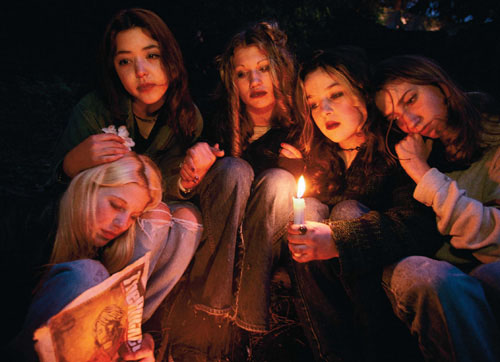
“Never underestimate the floor as a light source.”
Ever look at your subject and wonder why their face is all aglow with the light? It’s often because the light is coming from below. Look around. The light from the door or from the window... is it hitting the floor?
Never underestimate the floor as a light source. Set up your main light. Look average? Need a little glamour? A little fill? Throw a Lastolite panel[1] on the floor...or a fill board...or a bed sheet. Bounce a light into it at –2 EV off the main light value.
[1] Lastolite Panel: A kit that has both diffusion and reflective material that fits onto a rigid, collapsible frame. Comes in 3×3′, 3×6′, and 6×6′ sizes. Ideal for diffusing or flagging light sources, or simulating window light. Breaks down into a small, light duffel bag. Very roadworthy.
Presto. Your subject’s face starts to come alive, those undereye shadows soften, and your average executive, well, I’ll stop short of saying you’ll turn ‘em into George Clooney, but it’s helpful, let’s put it that way.
Don’t try this if your subject wears glasses. We’re talking hit city, bad reflections. But, if your subject is a high-fashion model in Shanghai and you’re shooting her in a hip nightclub, hit the floor and go for the glow!
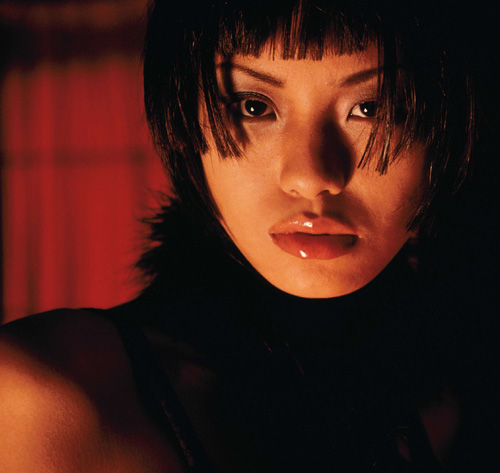
Mike Piazza
Always remember, being in front of the camera is a very vulnerable place to be and nothing makes your subject more queasy than to just be out there, alone, while you and the assistants hover, pace, look shaky, and talk pixels and f-stops. So radiate confidence!
It’s always amazing to me how a crew can voice doubts and talk techie, worrisome crap right within earshot of the photo subject. I always imagine it’s like the operating room chatter during a long, serious surgery. That doesn’t matter to the patient, ‘cause they’re knocked out. But your subject is right there, listening. If you’re fretting, so are they. “Is it all right? Is it serious? Am I gonna die?” Not good.
Think of it this way. You’re a passenger on an airliner, some green co-pilot is accidentally sitting on the intercom switch, and you hear somebody in the cockpit say, “What’s this button do?”
After 9/11, I shot Mike Piazza (for Sports Illustrated) sitting on the edge of a roof, 12 stories up, smoke in the skyline where the World Trade Center used to be. He and other New York athletes had stepped up to encourage and support the city.
“Your subject is right there, listening. If you’re fretting, so are they. ‘Is it all right? Is it serious? Am I gonna die?’ Not good.”
During the shoot, my heavily sandbagged and roped off strobe unit literally blew up. Flames started shooting out of the softbox. Not smoke, flames. Big ones. It looked for a minute like I had painted the Octa with a set of low rider decals.
I walked up to Mike and shrugged. The assistants were scurrying about, pulling it down, putting out the fire. Told him we had another unit, we’d have it running in about five minutes. Relax.
Remember, as insecure as you are behind the camera, they are doubly so in front of it. So, even though things are going to hell in a handbasket, give ‘em the old “this is just temporary, we’ve got it handled” look. Make ‘em feel good. (Even if you just peed your pants!)
“Every once in a while, it pays to listen to those annoying characters who are just waiting to tell you how to do your job.”
“Hey photographer!”
Don’tcha just hate that? I know I do. You’re out there with a camera and somebody just has to tell you you’re missing it. Or, “Hey, look over here! ‘Cause it’s a really good picture.”
I shouldn’t hate it though. Listening to somebody like that resulted in my first widely published photo. It was halftime at a Syracuse University football game and I was daydreaming, camera in hand, looking up at the stands, trying to ignore the band.
These two guys on the fence started shouting to me,“Hey photographer, turn around, there’s a guy in the band who’s gonna drop his pants!” I spun around and sure enough, there was this trumpet player trundling along with his mates, pants down at his ankles.
I had a Nikkormat and an old 300mm f/4.5. I charged the field (camera to my eye) and squeezed a frame just as he was recovering his trousers. Didn’t think much of it, really, except that I knew it wasn’t sharp.
Out of focus or not, it hit almost every paper in the country—even People magazine. Turns out it was a preconceived prank, for which the trumpeter was, as one account put it, “unceremoniously drummed from the band.”
Every once in a while, it pays to listen to those annoying characters who are just waiting to tell you how to do your job.
It never hurts to look.
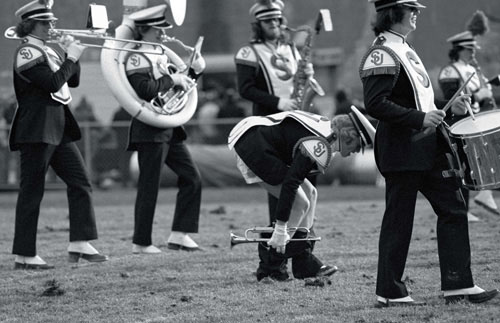
“There is a logic to light. It’s gotta come from somewhere, and something has to be making it.”
Steven Spielberg can get away with hot, smoky light coming from beneath the lost Ark of the Covenant, buried for 2,000 years in a crypt. We can’t.
There is a logic to light. It’s gotta come from somewhere and something has to be making it. That’s why it doesn’t really make sense to have somebody in a field staring at a hole in the ground with light coming from the hole. Unless you’re shooting production stills for The X-Files.
Try to be logical and give your reader something to hang onto. I often use a flashlight, which creates a reason for the light, plus it’s something you’d actually use if you were looking under a car hood, reading a map, or checking out a torpedo tube.
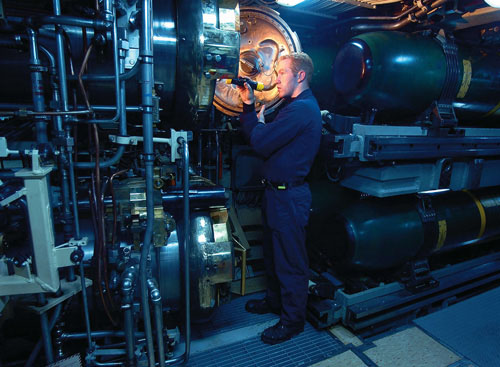
“I mean, it was a long line, kind of around the block. Have to admit, I was feeling pretty good about it. Jay fixed that.”
It’s good to have friends and mentors who keep you in line and keep your head on straight. Jay Maisel is such a friend to me, in addition to being a font of wisdom and an incredible talent.
I was doing a poster signing for Nikon at PhotoPlus one year, and I had a big line waiting for my signature, apparently oblivious to the fact that when I sign something, the value actually diminishes.
I mean, it was a long line, kind of around the block. Have to admit, I was feeling pretty good about it. Jay fixed that.
He saw me and motioned me over. “McNally,” he said, in his best Brooklyn accent. “McNally, I saw you had a big line for your poster. That’s nice. But don’t get a big head, McNally. McNally, if you were charging a nickel...no, no, wait...if you were charging a penny for those posters, there woulda been nobody on that line, McNally, nobody.”
You know something? He’s right.
You know something else? White’s tough to shoot, especially on digital. Especially white on white on white.
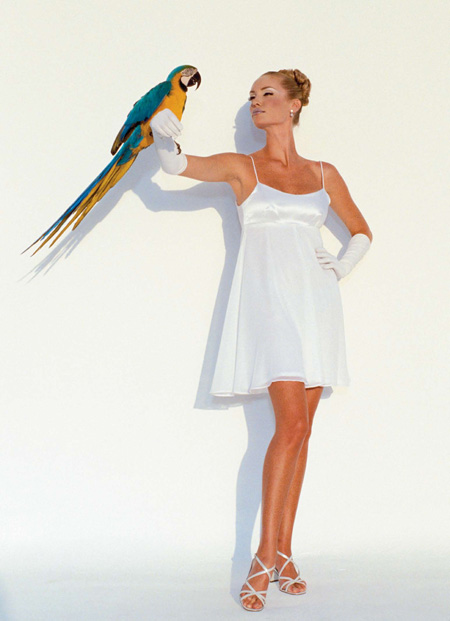
The Observer of London assigned me to photograph Ken Kesey, author of One Flew Over the Cuckoo’s Nest and the most famous of the Merry Pranksters. They evidently hadn’t checked with him.
I arrived at his house in Oregon, which was sort of like Times Square on New Year’s Eve—just more rural and fewer people.
At first, he ignored me. Then he avoided me. Then he wasn’t gonna pose.
“Make it clear you’re not leaving.”
“I don’t care how big the camera is, I won’t salute it,” he declared, saluting me instead.
Luckily, he had this great hammock on his front lawn and it was summer. I took a long nap. Came back the next day and did the same. Went to lunch. Came back. Took another nap.
Late on the second day, he came outside. “Wanna go feed the cows?” (On location, when your subject asks you a question like that, say yes.)
So Kesey and I started throwing bales of hay off the back of a moving pickup truck to a bunch of hungry heifers. “This stuff is like tai stick for cows,” he said, taking a long pull on what distinctly looked like tai stick between his lips.
He relaxed after that, got in his Eldorado with his cocker spaniel, and I got a picture. I think he just wanted me to leave.

Ken Kesey

Mike Ruth
I occasionally went to the picture picking session at Sports Illustrated. When slides were shown, the managing editor at the time was generally the only one who spoke. He would sit there eating ice cream or generally snacking on something, and if he liked a picture, he would call out, “Yanko,” meaning to yank it from the slide tray as a select. There would be a burble of approval around the room. If he reeeeaaaaalllllly liked it, he would call out, “Yanko Supremo.” More burbling.
I had never realized I was out there looking not for pictures, but for yanko supremos.
This one I believe got at least a yanko. Maybe even a supremo. The story was about Mike Ruth, a massive defensive lineman for Boston College and winner of the Outland Trophy as the nation’s best defensive player. He was a surefire first rounder and big news, so I was dispatched to shoot some pictures.
Size is a tough thing to show in a photo, believe it or not. I was once assigned to photograph the biggest guys in the NFL, and I failed miserably. Biggest in relation to what? I put guys in meat lockers à la Rocky, on a bulldozer, lifting things, you name it. The only thing I got out of it was the biggest bill I have ever run up in a Red Lobster, when I caused the front line of the Indianapolis Colts to miss their training camp dinner. I had to spring for a meal. Each of them ordered two entrees.
“Remember to think like a comic book: low angle, look up! Turn your subject into a superhero!”
So, when I saw the summer sun dipping towards this hill and Mike was shirtless, finished with his workout, I grabbed a 400mm lens and asked him to go to the crest of the hill and do something athletic.
The pale haze muted the colors and made the sun shootable as a perfect round ball. Mike did some stretches, and I got a photo USA Today called the best sports photo of that week.
“Comic books tell wonderful stories. They have color, punch, drama, and great POV (point of view) on the action.”
Bam! Splat! Pow! Aaarggh! Zoom!
I grew up on comic books. I went to five different grammar schools. Always the new kid. I had to find something to do besides get the $#!& kicked out of me during recess.
It informs my pictures now. Primary colors. Dramatic gestures. Screamin’ light. I’m thoroughly unabashed about this. Comic books tell wonderful stories. They have color, punch, drama, great POV (point of view) on the action, and they make Zod, evil overlord of the Darthmanian nebula system, very real. At least for me.
So when I get the world’s largest Van der Graaf generator in front of my lens, I’m in heaven. Or Frankenstein’s castle. I’m thinking up a world of color, light, monsters, and heroes, and man, to borrow a phrase, “It’s Clobberin’ Time!”
A picture like this is a trip into the valley of the gels and the enemy here is white light bleed. That sounds like a horrible dermatological condition, but it is actually about the lighting, and generally results from being careless or lazy. When you want to just generally warm a scene up, for instance, it is cool to loosely tape warm gels on the strobe heads. Most of the light goes through the gel, some white light jumps out through open spaces between the gel and the head. No problem.
But, if you want rich, saturated color, ya gotta seal the light with the gel. Tape it on carefully and allow no open seams for white light to scream outta there. White light bleed will turn red pink, and give you punchless color.
Another point: when you don’t have a good blue, for instance, a first, logical instinct might be to turn up the power on the flash. Want more color? Give it the gas! More power! No. Wrong. You make the color richer and stronger by dialing down the light. Less power, more color.
Eisie (Alfred Eisenstaedt) always used to say, bring the stuff with you, it doesn’t do you any good back at the studio. He was right.
But just ’cause you got it, don’t mean you have to use it.
I dragged a bunch of strobes to the roof of the Tropicana in Vegas to shoot Linda Donohue, the “Showgirl of the Year.”
It was tough. Lots of stairs, wind, thunderstorm gathering, puddles of water everywhere. Makes you feel good about using large power packs.
“Just ‘cause you got it, don’t mean you have to use it.”
I was so blinkered about using all this gear, thinking strobe, strobe, strobe, that I totally forgot I was there to make a picture. Wasn’t the first time this had happened. I shudder to think about how many pictures I’ve missed while pursuing what I thought was gonna be the one. Sorta like dating, you know?
Anyway, common sense seized me and I looked at the subject, who was fussing with her feathers. A thought crackled through my remaining synapses...that looks fantastic! I put my eye into the camera and went click. We were done.
Thankfully the picture ran, and Linda was rewarded for climbing a 20-foot steel rung ladder in her dancing shoes, a G-string, and feathers.
Of course, if you think sweet, simple available light and you don’t bring all this crap up there with you, you’ll need it. Welcome to photography!

“Sometimes the Best light happens after the light is Gone.”
You have to resist the urge to pack your stuff up when the sun goes below the horizon, because some of those last, lingering, luminous fingers of light can be some of the most beautiful of the day. You have to be careful when you work, because the light’s real pretty, but there ain’t much of it, so you’re going to have to use a slow shutter speed. I was able to hand-hold this shot, with a one-second exposure, but I don’t recommend this—this is where a tripod is your friend.
This is also the water trick at play again. Without the sheen of water as the waves hit the shore, there would be no separation, and no picture. The lengthy exposure helps here. As the water rushes along the beach, it is in motion, and the highlight spreads.
By the way, when you are stuck without a tripod, use anything you can get your hands on to stabilize the camera. Bill Allard at National Geographic is famous for using a beer bottle monopod. If there is nothing around, as there wasn’t in this situation, sit down Indian-style and brace your elbows on your knees. Or, being at the beach, smush together a towel on the ground and nestle the camera in it. You sacrifice a bit of the ideal camera angle you might have wanted, but you get a frame.
